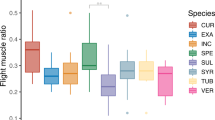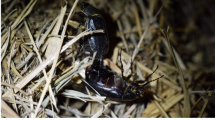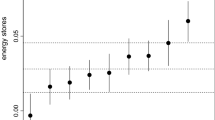Abstract
We determined the flight capabilities and feeding habits of adults of nine silphine beetle species and illustrated their relationship. We examined the silphine beetles for the presence or absence of flight muscles and estimated their feeding habits by comparing the carbon and nitrogen stable isotope ratios for them with those of necrophagous nicrophorine species and carnivorous carabine species. Three species (Silpha longicornis, S. perforata and Phosphuga atrata) completely lacked individuals with flight muscles, and one species (Eusilpha japonica) showed flight muscle dimorphism. Stable isotope analysis suggested that these species were carnivores, mainly feeding on soil invertebrates. Most flight species showed higher isotopic ratios than the flightless species. Some of them have isotopic ratios close to those of the nicrophorine species, suggesting that these species mainly feed on vertebrate carcasses. Flightless silphine species would have limited ability to search for patchy and unpredictable carcass resources. Further studies are necessary to understand the adaptive evolution of flight capability and the feeding habits in this group.

Similar content being viewed by others
References
Anderson RS, Peck SB (1985) The insects and arachnids of Canada, part 13. Biosystematics Research Institute, Ottawa, Canada
Cho YB, Kwon YJ (1999) New silphids (Coleoptera: Silphidae) from Korea. Kor J Ent 29:221–223
Crowson RA (1981) The biology of the Coleoptera. Academic, Oxford
Deniro MJ, Epstein S (1978) Influence of diet on the distribution of carbon isotopes in animals. Geochim Cosmochim Acta 42:495–506
Deniro MJ, Epstein S (1981) Influence of diet on the distribution of nitrogen isotopes in animals. Geochim Cosmochim Acta 45:341–351
Dobler S, Müller JK (2000) Resolving phylogeny at the family level by mitochondrial cytochrome oxidase sequences: phylogeny of carrion beetles (Coleoptera, Silphidae). Mol Phylogenet Evol 15:390–402
Eggert AK, Müller JK (1997) Biparental and social evolution in burying beetles: lessons from the larder. In: Choe JC, Crespi BJ (eds) The evolution of social behavior in insects and arachnids. Cambridge University Press, Cambridge, pp 216–236
France R (1995) Critical examination of stable isotope analysis as a means for tracing carbon pathways in stream ecosystems. Can J Fish Aquat Sci 52:651–656
Harrison RG (1980) Dispersal polymorphisms in insects. Annu Rev Ecol Syst 11:95–118
Heymons R, Lengerken Hv, Bayer M (1927) Studien über die Lebenserscheinungen der Silphini (Coleopt.). 2. Phosphuga atrata L. Z Morph Ökol Tiere 9:271–312
Heymons R, Lengerken Hv, Bayer M (1928) Studien über die Lebenserscheinungen der Silphini (Coleopt.). 3. Xylodrepa quadripunctata L. Z Morph Ökol Tiere 10:330–352
Heymons R, Lengerken Hv, Bayer M (1929) Studien über die Lebenserscheinungen der Silphini (Coleopt.). 4. Blitophaga opaca L. (Glattstreifiger Rübenaaskäfer). Z Morph Ökol Tiere 14:234–260
Hobson KA (1999) Stable-carbon and nitrogen isotope ratios of songbird feathers grown in two terrestrial biomes: implications for evaluating trophic relationships and breeding origins. Condor 101:799–805
Hobson KA, Drever MC, Kaiser GW (1999) Norway rats as predators of burrow-nesting seabirds insights from stable isotope analysis. J Wildl Manage 63:14–25
Hori S (2004) The ground beetle fauna of Okushiri Island and influence of predation by raccoon dog (in Japanese with English summary). Bull Hist Mus Hokkaido 32:1–20
Hori S, Matoba Y (2001) Arthropods recognized from the contents in the digestive tract of raccoons (in Japanese with English summary). Bull Hist Mus Hokkaido 29:67–76
Kamimura K, Nakane T, Koyama N (1964) Seasonal and altitudinal distribution of beetles in Mt. Jonen, the Japan Alps, with descriptions of new species, I. Sc Rep Kyoto Pref Univ 15:17–38
Katakura H, Fukuda H (1975) Faunal makeup of ground and carrion beetles in Kamiotoineppu, Hokkaido Nakagawa Experiment Forest, Northern Japan, with some notes on related problems. Res Bull Hokkaido Univ For 32:75–92
Katakura H, Ueno R (1985) A preliminary study on the faunal make-up and spatio-temporal distribution of carrion beetles (Coleoptera: Silphidae) on the Ishikari coast, northern Japan (in Japanese). Jpn J Ecol 35:461–468
Koba K, Hirobe M, Koyama L, Kohzu A, Tokuchi N, Nadelhoffer KJ, Wada E, Takeda H (2003) Natural 15N abundance of plants and soil N in a temperate coniferous forest. Ecosystems 6:457–469
Kohzu A, Yoshioka T, Ando T, Takahashi M, Koba K, Wada E (1999) Natural 13C and 15N abundance of field-collected fungi and their ecological implications. New Phytol 144:323–330
Kurata K, Minami H, Kikuchi E (2001) Stable isotope analysis of food sources for salt marsh snails. Mar Ecol Prog Ser 223:167–177
Kurosawa Y (1985) Silphidae. In: Uéno S, Kurosawa Y, Satoh M (eds) The Coleoptera of Japan, in color, vol 2 (in Japanese). Hoikusha, Osaka, pp 249–250
Leschen RAB (1993) Evolutionary patterns of feeding in selected Staphylinoidea (Coleoptera): shifts among food textures. In: Rockstein M (eds) Functional morphology of insect feeding. Entomological Society of America, Lanham, MD, pp 59–104
McNabb DM, Halaj J, Wise DH (2001) Inferring trophic positions of generalist predators and their linkage to the detrital food web in agroecosystems: a stable isotope analysis. Pedobiologia 45:289–297
Meinwald J, Roach B, Hicks K, Alsop D, Eisner T (1985) Defensive steroids from a carrion beetle (Silpha americana). Experientia 41:516–519
Minagawa M, Wada E (1984) Stepwise enrichment of 15N along food chains: further evidence and the relation between δ15N and animal age. Geochim Cosmochim Acta 48:1135–1140
Nagano M, Suzuki S (2003) Spatio-temporal distribution and food-searching strategy differentiations between two silphid beetles, Eusilpha japonica and E. brunnicollis (Coleoptera, Silphidae). Elytra 31:199–208
Nishikawa M (2003) A silphid mandala—recent knowledges on the East Asian fauna (in Japanese). Nat Insect 38:19–22
Ratcliffe BC (1972) The natural history of Necrodes surinamensis (Fabr.) (Coleoptera: Silphidae). Trans Am Ent Soc 98:359–410
Ratcliffe BC (1996) The carrion beetles of Nebraska. Bull Univ Nebraska St Mus 13:1–100
Scott MP (1998) The ecology and behavior of burying beetles. Annu Rev Ent 43:595–618
Tayasu I, Hyodo F, Abe T, Inoue T, Spain AV (2002) Nitrogen and carbon stable isotope ratios in the sympatric Australian termites, Amitermes laurensis and Drepanotermes rubriceps (Isoptera: Termitidae) in relation to their feeding habits and the quality of their food materials. Soil Biol Biochem 34:297–301
Trumbo ST, Kon M, Sikes D (2001) The reproductive biology of Ptomascopus morio, a brood parasite of Nicrophorus. J Zool 255:543–560
Uchida T, Kaneko N, Ito MT, Futagami K, Sasaki T, Sugimoto A (2004) Analysis of feeding ecology of earthworms (Megascolecidae) in Japanese forests using gut content fractionation and δ15N and δ13C stable isotope natural abundances. Appl Soil Ecol 27:153–164
Wagner DL, Liebherr JK (1992) Flightlessness in insects. Trends Ecol Evol 7:216–220
Zera AJ, Denno RF (1997) Physiology and ecology of dispersal polymorphism in insects. Annu Rev Entomol 42:207–231
Acknowledgments
We are grateful to Motohiko Kondo and Yuko Matsushita for analyzing some samples and helping to make samples, and to Seiichi Moriya for teaching us flight mill analysis. We would like to thank Takuya Fukuzawa, Ryôsuke Ishikawa, Noriko Iwai, Masahiro Nagano, Koji Sasakawa, Masahiko Tanahashi, Masayuki Ujiie and Hanae Yamashita for supplying us with some samples and for providing some advice about field collection, and to some of the members of the Laboratory of Silviculture, University of Tokyo, for lending us the bead cell disrupter.
Author information
Authors and Affiliations
Corresponding author
About this article
Cite this article
Ikeda, H., Kubota, K., Kagaya, T. et al. Flight capabilities and feeding habits of silphine beetles: are flightless species really “carrion beetles”?. Ecol Res 22, 237–241 (2007). https://doi.org/10.1007/s11284-006-0012-1
Received:
Accepted:
Published:
Issue Date:
DOI: https://doi.org/10.1007/s11284-006-0012-1




